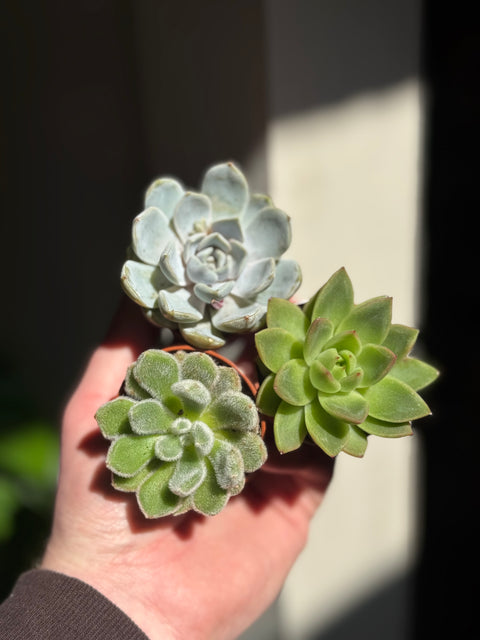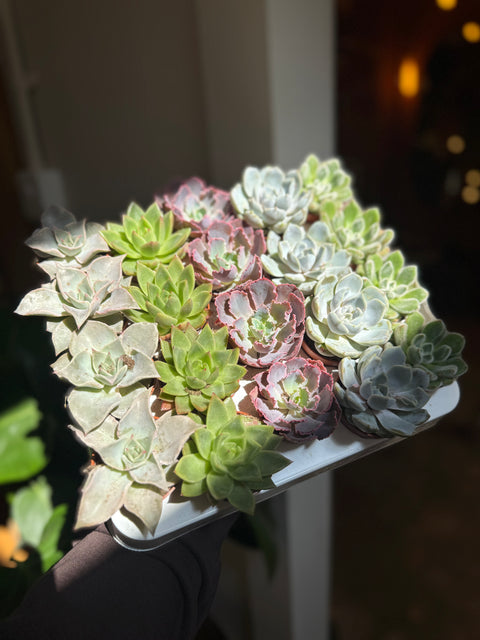


Echeveria Succulent Mixed
Aroma QuartzMixed Echeveria - Random Selection
Common Names: Echeveria, Mexican Hens and Chicks
Full Botanical Name: Echeveria spp. (assorted varieties)
Country and/or Region of Origin: Native to Central America, Mexico, and northwestern South America
Overview
Mixed Echeveria are a beautiful assortment of rosette-forming succulents, admired for their stunning symmetry, varied colors, and fleshy, geometric leaves. Each variety boasts its own unique charm—from powdery pastels to deep purples and vibrant greens—making them a favorite for succulent arrangements, terrariums, and sunny windowsills. With minimal care needs and sculptural appeal, they’re ideal for both beginners and collectors.
Growing Conditions in Native Habitat
In the wild, Echeveria grow in arid, rocky environments with excellent drainage and plenty of sunlight. They’re adapted to thrive with little water and lots of light, storing moisture in their plump leaves.
Care Guide
Light: Requires bright, direct sunlight to thrive. A south or west-facing window is ideal. If indoors, rotate the plant occasionally to maintain even growth.
Ideal Room: Best suited for sunny rooms like kitchens, conservatories, or bright living rooms.
Feeding: During the active growing season (spring to early autumn), feed monthly with a cactus or succulent fertilizer. No feeding is needed during dormancy.
Humidity: Prefers low humidity and good airflow. Avoid placing in overly humid areas like bathrooms.
Ideal Temperature: Prefers warm temperatures between 65–80°F (18–27°C). Keep away from cold drafts or temperatures below 50°F (10°C).
Watering: Water thoroughly only when the soil is completely dry. Use the “soak and dry” method and ensure excess water drains freely. In winter, reduce watering to prevent root rot.
Pet/Child Safe: Generally non-toxic to pets and children, though some varieties may cause mild stomach upset if ingested. Supervision is still recommended.
Soil Type: Requires a fast-draining, gritty soil mix—ideally a cactus or succulent mix with added perlite or sand for aeration.
Propagation: Easily propagated through leaf cuttings, offsets (pups), or by separating rosettes. Allow cuttings to callous over before planting.
Eventual Height and Spread: Most Echeveria stay compact, typically reaching 4–12 inches (10–30 cm) in height and spread depending on the variety.
Growth Rate: Moderate. Growth speeds up during the warmer seasons with proper care.
Pests and Treatment: Keep an eye out for mealybugs, aphids, or fungal gnats. Treat with insecticidal soap or neem oil if needed, and ensure proper drying between waterings to discourage pests.
Repotting: Repot every 1–2 years or when the plant outgrows its container. Choose a slightly larger pot with excellent drainage.
Pruning: Remove dead or dried leaves at the base to keep the plant tidy and prevent pest infestations. Pruning leggy stems can encourage compact regrowth.
Air Purification: While not a top air-purifier, Echeveria contribute to improving indoor air quality and offer mental wellness benefits through their aesthetic and calming presence.
Folklore: Echeveria are often associated with endurance, beauty, and lasting affection. In Feng Shui, their rosette shape is believed to invite harmony and balance into a home or workspace.
